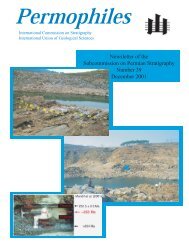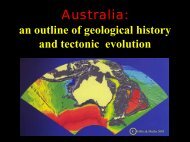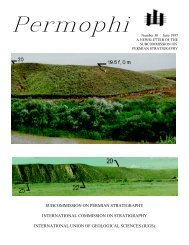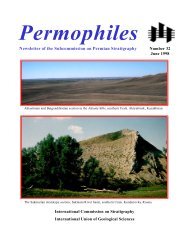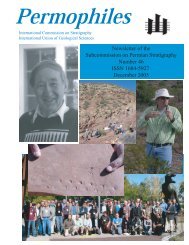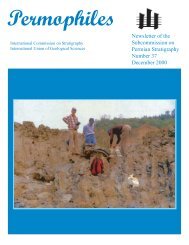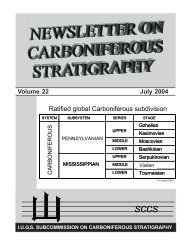Number 31 January 1998 Newsletter of the Subcommission on ...
Number 31 January 1998 Newsletter of the Subcommission on ...
Number 31 January 1998 Newsletter of the Subcommission on ...
Create successful ePaper yourself
Turn your PDF publications into a flip-book with our unique Google optimized e-Paper software.
quency sequences c<strong>on</strong>sisted <str<strong>on</strong>g>of</str<strong>on</strong>g> wackest<strong>on</strong>e-packst<strong>on</strong>egrainst<strong>on</strong>e<br />
limest<strong>on</strong>es with col<strong>on</strong>ial corals, interpreted as midplatform<br />
and shoal deposits. The Shikhanian deposits form a<br />
third order sequence (AS5, Fig. 2) with facies <str<strong>on</strong>g>of</str<strong>on</strong>g> mid-platform in<br />
MFP, and mid-platform and shoal in <str<strong>on</strong>g>the</str<strong>on</strong>g> HST.<br />
The Sakmarian, studied <strong>on</strong> <str<strong>on</strong>g>the</str<strong>on</strong>g> Belaya Gora cross-secti<strong>on</strong>, is<br />
subdivided into two substages: <str<strong>on</strong>g>the</str<strong>on</strong>g> Tastubian and <str<strong>on</strong>g>the</str<strong>on</strong>g><br />
Sterlitamakian. The Tastubian presents two third order sequences<br />
SAI and SA2 and <str<strong>on</strong>g>the</str<strong>on</strong>g> Sterlitamakian <strong>on</strong>e third order<br />
sequence SA3 (Fig. 2). The sequence SAI exhibits thirty three<br />
shallowing upward high frequency sequences composed <str<strong>on</strong>g>of</str<strong>on</strong>g><br />
wackest<strong>on</strong>e-grainst<strong>on</strong>e or wackest<strong>on</strong>e-packst<strong>on</strong>e limest<strong>on</strong>es<br />
with col<strong>on</strong>ial corals deposited <strong>on</strong> <str<strong>on</strong>g>the</str<strong>on</strong>g> mid-platform and shoal<br />
during <str<strong>on</strong>g>the</str<strong>on</strong>g> transgressive system tract (TST) and HST, and<br />
Palaeoaplysina small reef-wackest<strong>on</strong>e-packst<strong>on</strong>e limest<strong>on</strong>es<br />
deposited <strong>on</strong> <str<strong>on</strong>g>the</str<strong>on</strong>g> mid-platform and shoal during <str<strong>on</strong>g>the</str<strong>on</strong>g> MFP. The<br />
sequence SA2 presents twenty-two shallowing upward high<br />
frequency sequences composed <str<strong>on</strong>g>of</str<strong>on</strong>g> Palaeoaplysina small reefwackest<strong>on</strong>e-packst<strong>on</strong>e<br />
limest<strong>on</strong>es deposited <strong>on</strong> <str<strong>on</strong>g>the</str<strong>on</strong>g> mid-platform<br />
during <str<strong>on</strong>g>the</str<strong>on</strong>g> TST and <str<strong>on</strong>g>the</str<strong>on</strong>g> MFP. The sequence SA3 shows<br />
twenty shallowing upward high frequency sequences composed<br />
<str<strong>on</strong>g>of</str<strong>on</strong>g> Palaeoaplysina small reef-wackest<strong>on</strong>e (2-10m) and silicified<br />
wackest<strong>on</strong>e-packst<strong>on</strong>e limest<strong>on</strong>es deposited <strong>on</strong> <str<strong>on</strong>g>the</str<strong>on</strong>g> mid-platform<br />
and outer platform.<br />
The Artinskian, studied <strong>on</strong> <str<strong>on</strong>g>the</str<strong>on</strong>g> Belaya Gora cross-secti<strong>on</strong>, is<br />
subdivided into four substages : <str<strong>on</strong>g>the</str<strong>on</strong>g> Burtsevkian, Irginian,<br />
Sarginian and Saranian. The Artinskian presents <strong>on</strong>e composite<br />
carb<strong>on</strong>ate third order sequence (AR 1 -2) corresp<strong>on</strong>ding<br />
to <str<strong>on</strong>g>the</str<strong>on</strong>g> Bursevkian and Irginian deposits and <strong>on</strong>e composite<br />
turbiditic third order sequence (AR3-4) corresp<strong>on</strong>ding to <str<strong>on</strong>g>the</str<strong>on</strong>g><br />
Sarginian and Sarinian deposits. The Bursevkian exhibits three<br />
shallowing upward high frequency sequences and <str<strong>on</strong>g>the</str<strong>on</strong>g> Irginian<br />
thirteen composed <str<strong>on</strong>g>of</str<strong>on</strong>g> silicified wackest<strong>on</strong>e-packst<strong>on</strong>e limest<strong>on</strong>es<br />
deposited <strong>on</strong> <str<strong>on</strong>g>the</str<strong>on</strong>g> outer platform in fr<strong>on</strong>t <str<strong>on</strong>g>of</str<strong>on</strong>g> <str<strong>on</strong>g>the</str<strong>on</strong>g> reef located<br />
now westward <str<strong>on</strong>g>of</str<strong>on</strong>g> this area. For Artinskian, this analysis<br />
can be completed in <str<strong>on</strong>g>the</str<strong>on</strong>g> reef area <str<strong>on</strong>g>of</str<strong>on</strong>g> Sylvinsk (Ozhglbesov et al.,<br />
1993), where sequences AR3 and AR4 are well exposed under<br />
reef and platform facies. During Sakmarian and Artinskian, <str<strong>on</strong>g>the</str<strong>on</strong>g><br />
paleoenvir<strong>on</strong>ments evolved from <str<strong>on</strong>g>the</str<strong>on</strong>g> mid-platform to <str<strong>on</strong>g>the</str<strong>on</strong>g> reef,<br />
outer platform and turbiditic basin (Figs.1, 2) with a migrati<strong>on</strong> <str<strong>on</strong>g>of</str<strong>on</strong>g><br />
<str<strong>on</strong>g>the</str<strong>on</strong>g> reef area westwards (Chuvashov, 1983). A sec<strong>on</strong>d order<br />
sequence (13 in. M. Y.), interpreted as tect<strong>on</strong>ic origin, is observed<br />
during Sakmarian and Artinskian in this area, produced<br />
by <str<strong>on</strong>g>the</str<strong>on</strong>g> progressi<strong>on</strong> westwards <str<strong>on</strong>g>of</str<strong>on</strong>g> <str<strong>on</strong>g>the</str<strong>on</strong>g> Ural orogen and <str<strong>on</strong>g>of</str<strong>on</strong>g> <str<strong>on</strong>g>the</str<strong>on</strong>g><br />
Ural foreland basin <strong>on</strong> <str<strong>on</strong>g>the</str<strong>on</strong>g> Russian platform. In <str<strong>on</strong>g>the</str<strong>on</strong>g> Gubakha<br />
area, <str<strong>on</strong>g>the</str<strong>on</strong>g> c<strong>on</strong>trol <str<strong>on</strong>g>of</str<strong>on</strong>g> <str<strong>on</strong>g>the</str<strong>on</strong>g> sequences is eustatic and tect<strong>on</strong>ic during<br />
Asselian and Sakmarian, and tect<strong>on</strong>ic during Artinskian.<br />
Comparis<strong>on</strong> with <str<strong>on</strong>g>the</str<strong>on</strong>g> Sou<str<strong>on</strong>g>the</str<strong>on</strong>g>rn Urals and Southwestern<br />
North America<br />
Unfortunately <str<strong>on</strong>g>the</str<strong>on</strong>g> c<strong>on</strong>tinuity <str<strong>on</strong>g>of</str<strong>on</strong>g> sequences can not be fully<br />
c<strong>on</strong>trolled without bore holes data between <str<strong>on</strong>g>the</str<strong>on</strong>g> field secti<strong>on</strong>s<br />
<str<strong>on</strong>g>of</str<strong>on</strong>g> <str<strong>on</strong>g>the</str<strong>on</strong>g> central and sou<str<strong>on</strong>g>the</str<strong>on</strong>g>rn Urals. Sec<strong>on</strong>d and third order sequences<br />
can be <strong>on</strong>ly compared between <str<strong>on</strong>g>the</str<strong>on</strong>g> cross-secti<strong>on</strong>s. In<br />
<str<strong>on</strong>g>the</str<strong>on</strong>g> reef area (Skakhtau Shikhan), Rauser-Chemousova and<br />
Korolyuk (1993) described Asselian as biohermal limest<strong>on</strong>es<br />
with Tubiphytes and bryozoa and with a hiatus at <str<strong>on</strong>g>the</str<strong>on</strong>g> top;<br />
Tastubian as biohermal limest<strong>on</strong>es with bryozoa,<br />
Palaeoaplysina and col<strong>on</strong>ial corals and bioclastic limest<strong>on</strong>es ;<br />
Sterlitamakian as massive Palaeoaplysina biohermal limest<strong>on</strong>e<br />
18<br />
(thickness 100m) and dark micritic limest<strong>on</strong>e; Artinskian as<br />
bryozoa limest<strong>on</strong>es filling large cracks at <str<strong>on</strong>g>the</str<strong>on</strong>g> top <str<strong>on</strong>g>of</str<strong>on</strong>g> <str<strong>on</strong>g>the</str<strong>on</strong>g> reef and<br />
marl with sp<strong>on</strong>ge spicules. Venin (1996) described four sequences<br />
composed <str<strong>on</strong>g>of</str<strong>on</strong>g> high frequency sequences: <strong>on</strong>e incomplete<br />
in Asselian, <strong>on</strong>e for Tastubian, <strong>on</strong>e for Sterlitamakian and<br />
<strong>on</strong>e incomplete for Artinskian. In <str<strong>on</strong>g>the</str<strong>on</strong>g> Ural foreland basin, in<br />
Aidalarash creek (Snyder and Gallegos, 1997), <str<strong>on</strong>g>the</str<strong>on</strong>g> Asselian and<br />
Sakmarian presents three sequences, <str<strong>on</strong>g>the</str<strong>on</strong>g> Sterlitamakian and<br />
Artinskian seven sequences. But, <str<strong>on</strong>g>the</str<strong>on</strong>g> sequences deposited at<br />
<str<strong>on</strong>g>the</str<strong>on</strong>g> eastern part <str<strong>on</strong>g>of</str<strong>on</strong>g> <str<strong>on</strong>g>the</str<strong>on</strong>g> foreland basin near <str<strong>on</strong>g>the</str<strong>on</strong>g> Urals are certainly<br />
tect<strong>on</strong>ic c<strong>on</strong>trolled. Ross and Ross (1987, 1994, 1995)<br />
published <str<strong>on</strong>g>the</str<strong>on</strong>g> Permian sequence stratigraphy with a comparis<strong>on</strong><br />
between <str<strong>on</strong>g>the</str<strong>on</strong>g> Sakmar area (foreland basin, sou<str<strong>on</strong>g>the</str<strong>on</strong>g>rn Urals)<br />
and <str<strong>on</strong>g>the</str<strong>on</strong>g> southwestern North America. They described five<br />
third order sequences during Asselian (four for <str<strong>on</strong>g>the</str<strong>on</strong>g> Nealian and<br />
<strong>on</strong>e composite during Shikhanian eroded in USA), four or five<br />
third order sequences during Sakmarian (four for <str<strong>on</strong>g>the</str<strong>on</strong>g> Lenoxian<br />
and <strong>on</strong>e during Sterlitamakian lacking in USA), three or four<br />
third order sequences during Artinskian (Hessian), <strong>on</strong>e composite<br />
or two third order sequences during Kungurian<br />
(Ca<str<strong>on</strong>g>the</str<strong>on</strong>g>dralian). By comparis<strong>on</strong> <str<strong>on</strong>g>the</str<strong>on</strong>g> number <str<strong>on</strong>g>of</str<strong>on</strong>g> sequences in all<br />
<str<strong>on</strong>g>the</str<strong>on</strong>g> cross-secti<strong>on</strong>s is different: five during Asselian, <strong>on</strong>e, three<br />
or five during Sakmarian, two composite or four during<br />
Artinskian, <strong>on</strong>e or two during Kungurian. The building <str<strong>on</strong>g>of</str<strong>on</strong>g> a<br />
sequence stratigraphy in <str<strong>on</strong>g>the</str<strong>on</strong>g> Lower Permian is difficult because<br />
<str<strong>on</strong>g>of</str<strong>on</strong>g> <str<strong>on</strong>g>the</str<strong>on</strong>g> erosi<strong>on</strong> <str<strong>on</strong>g>of</str<strong>on</strong>g> sequences, <str<strong>on</strong>g>the</str<strong>on</strong>g> stacking <str<strong>on</strong>g>of</str<strong>on</strong>g> sequences in <str<strong>on</strong>g>the</str<strong>on</strong>g><br />
case <str<strong>on</strong>g>of</str<strong>on</strong>g> composite sequence during <str<strong>on</strong>g>the</str<strong>on</strong>g> maximum transgressi<strong>on</strong><br />
and <str<strong>on</strong>g>the</str<strong>on</strong>g> tect<strong>on</strong>ic c<strong>on</strong>trol <str<strong>on</strong>g>of</str<strong>on</strong>g> <str<strong>on</strong>g>the</str<strong>on</strong>g> sequences. Thus, <str<strong>on</strong>g>the</str<strong>on</strong>g> Russian<br />
platform should be c<strong>on</strong>sidered as <str<strong>on</strong>g>the</str<strong>on</strong>g> best area to rec<strong>on</strong>struct<br />
sequence stratigraphy, <str<strong>on</strong>g>the</str<strong>on</strong>g> Ural foreland basin being too tect<strong>on</strong>ic<br />
to be a reference area.<br />
References<br />
Chuvashov, B. I., 1983. - Pennian Reefs <str<strong>on</strong>g>of</str<strong>on</strong>g> <str<strong>on</strong>g>the</str<strong>on</strong>g> Urals. Facies, 8:<br />
191-212, Erlangen.<br />
Ekhlakov, Y. A., 1993. - Gubakha regi<strong>on</strong>. In: B. I. Chuvashov and<br />
A. E.M. Naim (Eds), Permian system : guides to geological<br />
excursi<strong>on</strong>s in <str<strong>on</strong>g>the</str<strong>on</strong>g> uralian type localities. Pub ESRI, New Series<br />
10: 183-207.<br />
Ozhgibesov, V. P., S<str<strong>on</strong>g>of</str<strong>on</strong>g>r<strong>on</strong>itsky, P. A. and Dor<str<strong>on</strong>g>of</str<strong>on</strong>g>eyev, Y. P., 1993.<br />
- Kungur regi<strong>on</strong>. In: B. I. Chuvashov and A. E. M. Nairn<br />
(Eds), Permian system : guides to geological excursi<strong>on</strong>s in<br />
<str<strong>on</strong>g>the</str<strong>on</strong>g> uralian type localities. Pub ESRI, New Series 10 : 162-182.<br />
Rauser-Chernousova, D. M. and Koryoluk, I. K., 1993.<br />
Sterltamakian Shikhans: early Permian reefs. In: B. I.<br />
Chuvashov and A. E. M. Naim (Eds), Permian system: guides<br />
to geological excursi<strong>on</strong>s in <str<strong>on</strong>g>the</str<strong>on</strong>g> uralian type localities. Pub<br />
ESRI, New Series 10 : 72-85.<br />
Ross, C. A. and Ross, J. R. P., 1987. - Late paleozoic sea levels<br />
and depositi<strong>on</strong>al sequences. Cushman Foundati<strong>on</strong> for Foraminiferal<br />
Research, Sp. Pub. 24: 137-149.<br />
Ross, C. A and Ross, J. R. P., 1994. - Permian Sequence Stratigraphy<br />
and fossil Z<strong>on</strong>ati<strong>on</strong>. In : A. F; Embry, B. Beauchamp<br />
and D. Glass (Eds), Pangea : Global Envir<strong>on</strong>ments and Resources.<br />
Can. Soc. Petrol. Geologists, Mem. 17 : 219-23 1.<br />
Ross, C. A. and Ross, J. R. P., 1995. - Permian Sequence Stratigraphy.<br />
In : P. A. Scholle, T. M. Peryt and D. S. Ulmer-Scholle<br />
(Eds), The Permian <str<strong>on</strong>g>of</str<strong>on</strong>g> nor<str<strong>on</strong>g>the</str<strong>on</strong>g>rn Pangea, vol I : 98-123, Springer<br />
Verlag.<br />
Snyder, W. S. and Gallegos, D. M., 1997. - Sequence Stratigra-



